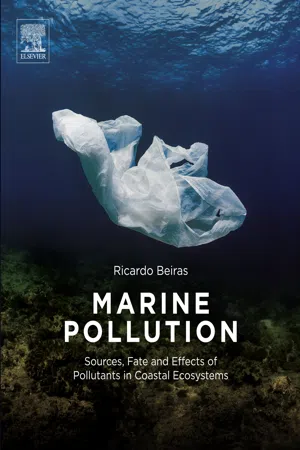
Marine Pollution
Sources, Fate and Effects of Pollutants in Coastal Ecosystems
- 408 pages
- English
- ePUB (mobile friendly)
- Available on iOS & Android
About this book
Marine Pollution: Sources, Fate and Effects of Pollutants in Coastal Ecosystems bring together the theoretical background on common and emerging marine pollutants and their effects on organisms (ecotoxicology). Written by a renowned expert in the field who is a researcher, teacher and advisor of national and international institutions on issues such as oil spills, water quality assessment and plastic pollution, this book offers a thorough account of the effects of pollutants on marine organisms, the relevant environmental regulations, and the public health implications, along with the biological tools advocated by the international institutions for marine pollution monitoring.Marine Pollution: Sources, Fate and Effects of Pollutants in Coastal Ecosystems presents information in a detailed and didactic manner, reviewing the latest scientific knowledge alongside examples of practical applications.- Provides an in-depth analysis of the uptake, accumulation and fate of pollutants in the marine compartments- Delivers a critical appraisal on biological tools for the practical monitoring of marine pollution- Presents key concepts and case studies to provide a comprehensive study of the different categories of marine pollution and its effects
Frequently asked questions
- Essential is ideal for learners and professionals who enjoy exploring a wide range of subjects. Access the Essential Library with 800,000+ trusted titles and best-sellers across business, personal growth, and the humanities. Includes unlimited reading time and Standard Read Aloud voice.
- Complete: Perfect for advanced learners and researchers needing full, unrestricted access. Unlock 1.4M+ books across hundreds of subjects, including academic and specialized titles. The Complete Plan also includes advanced features like Premium Read Aloud and Research Assistant.
Please note we cannot support devices running on iOS 13 and Android 7 or earlier. Learn more about using the app.
Information
Basic Concepts
Abstract
Keywords
1.1. Pollution, an Anthropogenic Process
Table of contents
- Cover image
- Title page
- Table of Contents
- Copyright
- Dedication
- Foreword
- Acknowledgments
- Abbreviations and Symbols
- Part I. Pollutants in Marine Ecosystems
- Part II. Marine Ecotoxicology
- Part III. Monitoring and Abatement of Marine Pollution
- Glossary
- Index